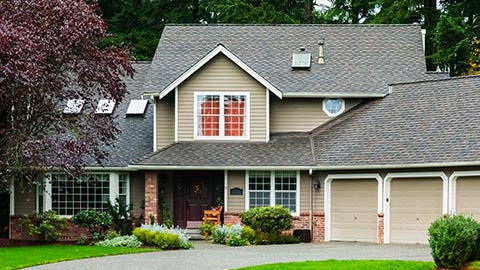Protecting your house, and the things that make it a home
Now's the time to get a home insurance quote
Home. It’s your safe haven. It’s where you raise your family and create memories that last a lifetime. Travelers can help you protect this prized possession with homeowners insurance that fits your priorities and your budget.
When you’re confident you have the coverage you need to help protect your home and personal belongings, you can focus on those little moments that matter.
Read transcript
(DESCRIPTION)
An umbrella pops up from the bottom of the screen. Text, Homeowners Insurance. The text, home insurance, appears in a search bar.
(SPEECH)
[MUSIC PLAYING]
Home insurance, why do you need it?
(DESCRIPTION)
A mouse cursor hits search. A red house logo pops up in a box. The box is replaced by a shield outline and dollar signs surround it on both sides.
(SPEECH)
Your home is most likely your biggest investment. Your homeowner's insurance can provide financial protection in a number of ways, such as if your home or personal property are damaged, if you or a family member are held legally responsible for injuries to others or damage to their property.
(DESCRIPTION)
The home icon has a fire on the roof. Outlines of a family are replaced by a judge banging a gavel. The following images appear as the narrator reads the list of coverage. A hand signs a document and the house gets a check mark beside it, a hammer bangs on a nail, the house with the fire returns, a watch gets a check mark beside it, a dollar bill falls into an open hand, a T-shirt, couch, and TV appear, a garage gets a check mark, a fence breaks, a hospital gets a check mark beside it, a stack of dollar bills appears, a dolly carries boxes, a person gets a check mark beside them, a hand gets a cast, and a house breaks a window.
(SPEECH)
Most home policies include the following coverages-- dwelling coverage, to repair your home if it's damaged by a covered cause of loss, such as a fire; personal property coverage, to reimburse you for damaged or destroyed contents in your home, like clothing, furniture, and electronics; other structures coverage, for damages to detached structures like garages and fences; loss of use coverage, to pay for housing and living expenses if you have to move out of your home while it's being repaired as a result of a covered loss; and liability coverage, in case you are responsible for causing injuries to other people or causing damage to their property.
For more answers, go to travelers.com.
(DESCRIPTION)
Logo, Travelers, Text, travelers.com. Legal disclaimer: The information in this video is general in nature. Any description of coverage is necessarily simplified. whether a particular loss is covered depends on the specific facts and the provisions, exclusions, and limits of the actual policy. Nothing in this video alters the terms or conditions of any of our policies. You should read the policy for a complete description of coverage. Coverage options, limits, discounts, and deductibles are subject to state availability and to individuals meeting our underwriting criteria. Not all features available in all states. Insurance is underwritten by The Travelers Indemnity Company and its property causality affiliates., One Tower Square, Hartford, Connecticut. In California, Home insurance is underwritten by The Standard Fire Insurance Company, One Tower Square, Hartford, Connecticut 06183, Certificate of Authority number 3545, State of Domicile: Connecticut. In Texas and Washington home insurance is underwritten by Travelers Personal Insurance Company. All underwriting companies listed above are located at One Tower Square, Hartford, Connecticut 06183.
Copyright 2022 The Travelers Indemnity Company. All rights reserved. Travelers and the Travelers Umbrella logo are registered trademark of The Indemnity Company in the U.S. and other countries.
What is home insurance?
Homeowners insurance can help protect you from the unexpected. If your home is damaged, your belongings are stolen or someone gets injured on your property, it can help cover repairs or replacement, temporary housing, legal fees and more.

Why do I need a homeowners insurance policy?
A homeowners policy is recommended for anyone who owns a home or condo and may be required by your mortgage lender. You will need separate coverages to help protect your home and personal belongings against damage due to floods or earthquakes.
If the unexpected happens, home property insurance can help you restore your life back to normal.

What does homeowners insurance cover?
A Travelers representative can help you determine the homeowners coverage that best fits your needs and budget. A typical policy can cover the structure of your home and other structures on your property, personal belongings, limited valuable items (extra coverage can usually be added), legal fees arising out of your personal liability and loss of use – additional living expenses if you cannot live at your home due to a covered loss.
Your homeowners insurance policy includes coverages in the categories below to help ensure your home and assets are appropriately protected. Explore these options and more to customize your limits and coverages.
Dwelling coverage
Dwelling coverage can help you pay to repair or rebuild your home if it is damaged by a covered event. Typically, you will want to have enough dwelling coverage to cover the estimated cost to repair, rebuild and replace your property.
Personal property coverage
Personal property coverage can pay you for the personal items in your home that may be damaged or destroyed by a covered cause of loss. These personal items could include your furniture, clothes, sporting goods and electronics.
Personal liability coverage
Liability coverage can help protect you in the event of a claim. If you or a family member in your household is responsible for causing bodily injury or property damage to others, this coverage can provide a defense in the event of a lawsuit.
Ways to save on homeowners insurance
You could save on your home insurance with multi-policy and loss-free discounts. You may also save if your home is equipped with qualified smart home technology, security and fire protective devices. There are several insurance discounts to consider when you explore homeowners insurance coverage to meet your needs. Consider the following opportunities for saving on your home insurance.
Multi-policy discount
With Travelers, when you have three policies with us, you can save on home insurance. These can include auto, umbrella, boat or a personal articles floater.
Protective device discount
You can save by having devices such as:
-
Automatic water shut-off systems
-
Smoke detectors and fire alarms
-
Interior sprinkler systems
-
Home security systems
-
Smart or connected home technology that alerts you when a fire, water or burglar event is occurring
Early quote discount
You can save up to 10% when you purchase a policy in advance of its effective date, depending on how far in advance you make your purchase.
Home insurance FAQs
Got questions? We have answers.
Explore common questions that are asked before, during or after purchasing home insurance.

OpenHouse
Your free home history report
We help you understand the history of major work and renovations for the home you plan to buy. OpenHouse helps you go beyond the paint and staging.
Related products
Jewelry & valuable items coverage
From jewelry to collectibles, you may have more valuables than you realize. And your home insurance policy may not provide the coverage you need.
Umbrella insurance
This liability coverage may go above and beyond your car and home insurance policies to help protect you from unexpected events.
Boat & yacht insurance
Knowing that you, your passengers and your vessel are protected can help you relax and enjoy your time on the water.
PREPARE & PREVENT
Insights to help you manage risks at home and on the road
Home Safety
Common Signs of Plumbing Problems
Water damage due to a plumbing problem in your home can be life-changing. But there are some common signs that homeowners can look for and steps they can take to help avoid a major water issue at home.

Buying & Selling
Buying vs. Renting a House: 5 Questions to Consider
What are the challenges of home ownership versus renting a home? Here are five questions to consider that may help you figure out what’s best for you.

Working Remotely
10 Tips for Staying Productive When Working from Home
Though technology can ease many of the challenges associated with working from home, it can't always help you stay productive. If you're finding it hard to stay on top of your tasks or meet your deadlines while working from home, these 10 tips can help.

